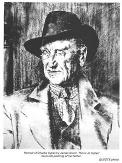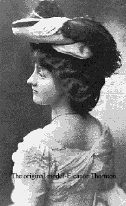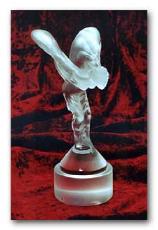SPIRIT OF ECSTASY Eleanor Thornton (centre) was of lowly stock, but her great intelligence and beauty helped her to become first a society belle, and later secretary (and lover) to John Montagu, the Second Lord Beaulieu. Montagu was a pioneer racing driver and MP, who'd introduced Mr Rolls to Mr Royce. Their illegitimate daugher, Joan, was adopted at birth by an employee of the estate. John and Eleanor were travelling to India on War Office business in 1915, when their ship The SS Persia was torpedoed without warning by a German U -boat - the first passenger ship to suffer such a fate in WWI. The German skipper, Max Valentiner, had, following the death of a close friend, become incensed by the new British tactic of disguising warships as merchantmen - known as Q-ships - and then opening fire as soon as a U-boat, under a convention known as the 'Cruiser Rules,' surfaced to demand surrender and evacuation before the sinking of any non-combatant ships. Eleanor was drowned, but Montagu survived - finally arriving back in London to read his own obituary. He soon tracked down their daughter and developed a close and loving relationship with her - but only as her 'uncle.' Evenually she did guess his real relationship, but it was not until many years later, when John died and the letter he'd written after Eleanor's death in case of his own death in WWI was finally delivered, that she heard this news officially. The family (John had continued having children with his wife after his and Eleanor's daughter was born). knew nothing of Joan's existance, but John had left her a substantial legacy, so this quickly changed. However, they did not know her wherabouts until one day when John's eldest daughter was introduced to a woman in a shop in Devon, 'this is your half-sister Joan!' Edward Lord Montagu soon visited his sibling and welcomed her into the family as a full member. At that point it emerged that by a staggering coincidence one of Joan's two sons (one of John and Eleanor's grandsons) worked as an engineer - at Rolls Royce! Eleanor was also friend and life model for John's protegé, the painter and sculptor Charles Sykes (right) - who made two sculptures of her; 'The Whisper' andthe most famous car mascot of all; 'Spirit of Ecstasy' (as well as a number of famous sporting trophies including the Cheltenham Gold Cup). It seems likely that Skyes met Thornton first. She was a life model at Chelsea Art school, where Tom's great great aunt, the painter Catherine Howard also studied - as did her brother-in-law Barry Parker, architect of Letchworth Garden Suburb, which was designed according to principles set down by the founder of the Garden City movement, social reformer Sir Ebenezer Howard (Tom's first cousin three times removed). (When Tom visited Beaulieu to photograph The Whisper for the album cover, Lord (Edward) Montagu showed him a bust of his father John sculpted by Kathleen Scott (nee Bruce), mother of Peter Scott - model for Philip in The Snow Goose - and Captain Robert Falcon Scott - of the Antarctic). and see below for news of a new film about this story Howard Phillips, Sykes' Grandson, has made this website of his Grandfather's works http://www.rilette.com She steps onto the gravel. The house looks so intimidating Nervously she tucks a wisp of hair beneath her hat And then bravely lifts the knocker, rehearsing her credentials It’s a job she feels well-suited to, and true, she needs the cash And if you or I had told her then that they would soon be lovers And for all his lordly bearing he’d be passionate and true She’d have smiled in sweet dismissal, I’ll only be his secretary He’s married with a daughter, and I’ll have far too much to do
Fly, Angel, Fly - The time has come to try Now the day is done, the dream begins The slipstream lifts those silver wings Away you drift to brighter things Across a beaming sky - Fly, Angel, fly!
Driving in the motor. It’s their only perfect privacy To talk about their passion, and the child that’s on the way Through the lanes to Beaulieu, maybe stroll upon the shingle Maybe gaze across the blue, to where the Solent meets the sea And she steps into my studio, and pours out all her troubles And I do my best to capture what might best be left unknown The laughter and the sparkle. The wit and the commitment But no whisper of the scandal that would bring a good man down
In those days of solemn duty, it would never do to question That his loyalty must be to king and country, and estate But when war demands a voyage, she’s more than indispensable They leave the children waving, as they steam towards their fate Sitting down to luncheon, in the safe Mediterranean Suddenly a lurch, as the torpedo finds its mark There’s no time for the lifeboats, there’s no more time for anything He holds her in his arms as they slide deep into the dark
He never could remember how the water came between them In the suffocating chill, in all the panic and the fear Three days in the open, clinging onto floating things And clinging to belief, and all the dreams they’d held so dear And he steps into my studio and pours out all his troubles And for all his lordly bearing he is desperate and lost And there upon the table stands the spirit of his lover And we stand and stare in wonder at the freedom - and the cost
Agony and the Ecstasy: The great Rolls-Royce love story (Daily Mail 01 05 08) By VICTORIA MOORE You can still feel the regret and despair, heavy in every word. 'I should have got a stronger grip on her,' wrote Lord Montagu in a letter home from his sickbed in Malta in 1916, after being rescued from the wreckage of the SS Persia which was hit by a German torpedo while crossing the Mediterranean. But to his enduring pain, Eleanor Thornton, his travelling companion, personal assistant and beloved mistress, had not been saved. "My father was shattered by Thorn drowning," says his son, the 81-year-old current Lord Montagu, using his father's pet name for Eleanor. "Theirs was a great love affair. Although when he came back home he was badly injured, he spent days looking for Thorn, who had been thrown overboard, searching everywhere, hoping that somehow she would turn up." Of course, she never did. But though the affair between the aristocrat and Eleanor Thornton ended with her death, their love was immortalised in the most unlikely of places. It was the inspiration for the Rolls-Royce flying lady, or 'Spirit of Ecstasy', whose soaring curves are modelled on Thorn and recognised by motorists across the world as a symbol of quality and distinction. Now Lord Attenborough is turning the story into a film - The Silver Ghost. It is a remarkable tale not merely because of the love story but also because Montagu's wife, Lady Cecil, not only knew about the affair, but condoned it. For her part, Eleanor had a child by Montagu but, knowing that as a single mother she would be unable to continue to work for Montagu, gave her daughter up for adoption. Born in Stockwell in 1880 to a Spanish mother and an Australian engineer, Eleanor Velasco Thornton left school at 16 and went to work at the Automobile Club (now the RAC). Through her work, she met all the motoring pioneers of the day, among them John Scott Montagu. Montagu was a charismatic figure, educated at Eton and Oxford, with a great interest in travel and transport. An MP for the New Forest Division of Hampshire, he was a great car enthusiast, who came third in the Paris-Ostend road race in 1899 and is credited with introducing King Edward VII to motoring. But he was also married to Lady Cecil 'Cis' Kerr, with whom he already had a daughter. When he met Miss Thornton, however, the effect was instantaneous. "I fell in love with her at first sight," he later said. "But as I couldn't marry her I felt I must keep away from her as much as I could. But she began to like me and realise my feelings as well." In 1902, when Eleanor was 22 and Montagu 36, she went to work as his assistant on Britain's first motoring magazine, Car Illustrated, in an office on London's Shaftesbury Avenue. He explained: "Before long, we discovered we loved each other intensely and our scruples vanished before our great love." It was a love whose light never went out. When Montagu's father died in 1905, John Scott inherited the title, becoming the second Baron Montagu of Beaulieu, and moved from the House of Commons to the Lords. Miss Thornton was still very much on the scene, increasing her duties as his assistant accordingly. Montagu owned a Rolls-Royce and would often take her for a spin along with Charles Sykes, an artist and sculptor. This is how Thorn came to inspire, and model for, the Spirit of Ecstasy. Montagu was friends with the managing director of Rolls-Royce and between them they cooked up a plan for an official sculpture, which at Montagu's suggestion Charles Sykes was commissioned to design. Sykes used Miss Thornton as a model and The Spirit of Ecstasy, or "Miss Thornton in her nightie", as those in the know called it, graced its first Rolls-Royce in 1911. Whether by this time Lady Cecil had worked out the truth about the relationship between her husband and his vibrant personal assistant is not clear, but by 1915, when Montagu had to leave for India to be Adviser on Mechanical Transport Services to the government of India, she certainly did. It had been decided that Miss Thornton would accompany Montagu onboard the SS Persia. Before the trip, Miss Thornton corresponded with Lady Cecil. Her tone is tender and conspiratorial. "I think it will be best for me to make arrangements without telling Lord Montagu - so he cannot raise objections," she writes. Later in the letter she writes, tellingly: "It is kind of you to give your sanction to my going as far as Port Said. You will have the satisfaction of knowing that as far as human help can avail he will be looked after." According to Montagu's biographer, the family felt that Lady Cecil "became resigned, with no feelings of bitterness to her husband's affair and took the view that if he had to take a mistress then it was as well he had chosen someone as sweet-natured as Eleanor Thornton - rather than someone who might cause a scandal." But their days on the SS Persia would be the last Montagu and Thornton spent together. They boarded the ship in Marseille on Christmas Day in 1915. Five days later, on December 30, they were sitting at a table having lunch when a German U-boat fired a torpedo at the ship's hull. The massive blast was repeated as one of the ship's boiler's exploded. As the ship began to list, icy seawater rushed in through the open port holes, and in the mayhem, Montagu and Eleanor made for the decks, which were already beginning to split. They considered trying to find a lifeboat but there was no time. One moment, Montagu had Eleanor in his arms, the next they were hit by a wall of water and she was gone. The port side of the ship was submerged within minutes and Montagu was dragged down with it. He was wearing an inflatable waistcoat and this, along with an underwater explosion that thrust him to the surface, probably saved his life. "I saw a dreadful scene of struggling human beings," he later cabled home. "Nearly all the boats were smashed. After a desperate struggle, I climbed on to a broken boat with 28 Lascars (Eastern sailors) and three other Europeans. "Our number was reduced to 19 the following day and only 11 remained by the next, the rest having died from exposure and injuries." They were eventually rescued, after 32 hours at sea with no food or water, by steamship Ningchow. Montagu convalesced in Malta, then returned home where he was flattered to read his own obituary, written by Lord Northcliffe, in the Times. The accident left him physically frail, but for years Montagu continued to search for his beloved Thorn. He also erected a memorial plaque in Beaulieu parish church beside the family pew, giving thanks for his own "miraculous escape from drowning" and "in memory of Eleanor Velasco Thornton who served him devotedly for 15 years" - an extraordinary public display of feeling under the circumstances. Lady Cecil died in 1919 and Montagu remarried the following year, to Pearl Crake whom he met in the South of France. She bore him a son, Edward, who is now the Third Baron Montagu of Beaulieu. But the repercussions of the love affair did not end with the deaths of the two women involved. The current Lord Montagu takes up the story. "My father died in 1929, when I was two and that was when the family discovered, by reading his will, that Eleanor had had a child. "The will made provision for her, but was worded to obscure who she was. We always used to wonder who she was and were keen to find her. "Then my half-sister Elizabeth went to live in Devon. She was standing in a fishmongers queue one day when someone said to her: 'See that woman over there? She's your sister'." The woman's name was Joan. She was born in 1903, soon after Montagu and Thornton began their affair, and given up for adoption straight away. The curious thing was that while Eleanor made no attempt to contact her daughter, Montagu had, on occasion, met up with her. He also wrote her a letter explaining the circumstances of her birth - "Your mother was the most wonderful and lovable woman I have ever met... if she loved me as few women love, I equally loved her as few men love..." - that she did not receive until after his death. Joan's behaviour was as discreet as her mother's. She had attended her father's funeral, but so quietly no one even noticed she was there. Says the current Lord Montagu: "Eventually, I got in touch and took her for lunch at the Ritz. We had oysters and she said: 'Your father always used to bring me here and we would have oysters, too." Joan married a surgeon commander in the Royal Navy and had two sons, one of whom, by sheer chance, worked for Rolls-Royce. Lord Montagu did as he knew his father would have wished. "I recognised them as full family," he says, apologising for the tears on his cheeks as he recounts the moving story. And so, a century after Eleanor Thornton and John Montagu met, their story has now passed into history. But the spirit of their feelings lives on, in the form of the figurine that still graces every Rolls-Royce. As the poet Philip Larkin once wrote: "What will survive of us is love" - and rarely has there been a more vivid illustration of that sentiment. | ||


